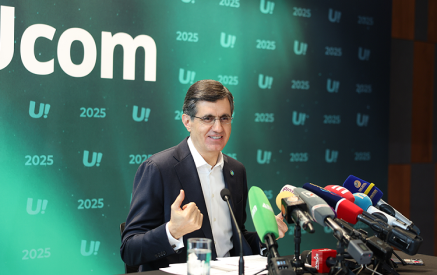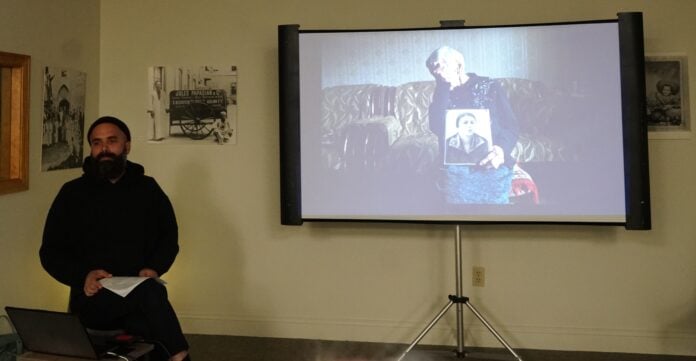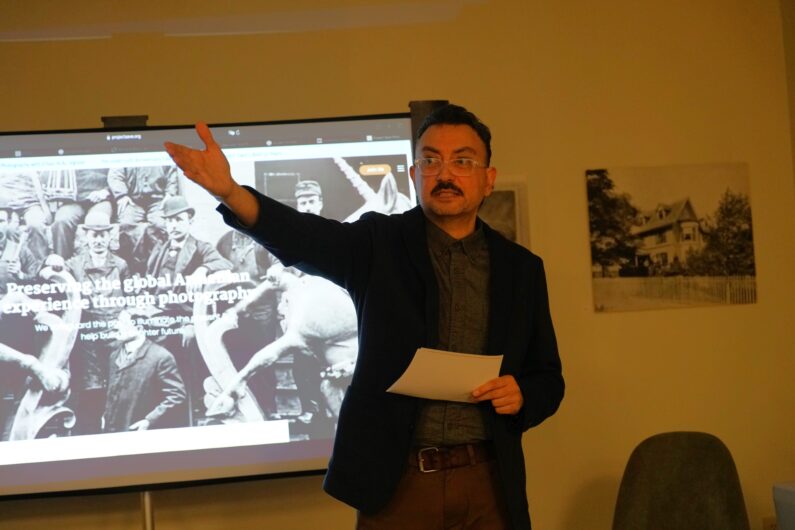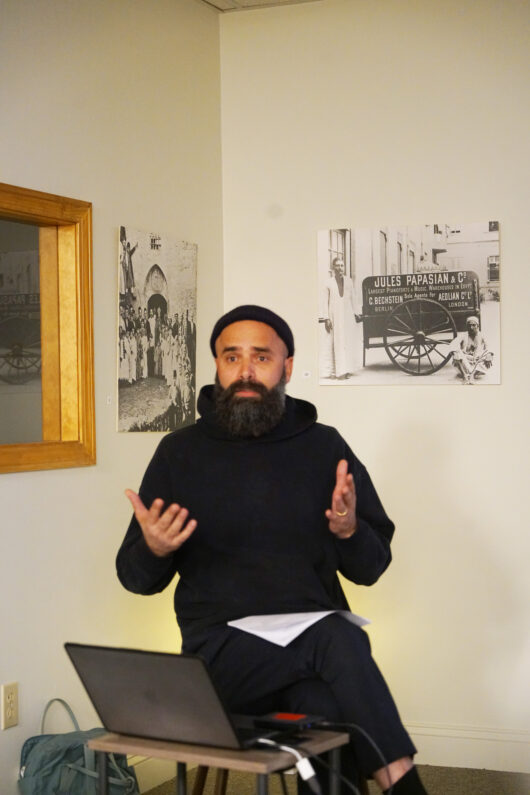by Aram Arkun
WATERTOWN — Project Save Photograph Archive presented as part of its “Conversations on Photography” series an illustrated talk on October 24 by Erhan at its new Watertown headquarters, which was cosponsored by the National Association for Armenian Studies and Research. Arık showed images of Armenian life in Armenia, Turkey and the Middle East from his trilingual 2016 book, Gayan [Station], printed in Istanbul by Aras Publishing.
The book includes photos of Armenian communities in Tehran, Isfahan, Zakho, Dohuk, Beirut, Jubail, Antelias, Ainjar, Amman, Jerusalem, Bethlehem, Bethany, Yerevan, Antakya and Istanbul, taken from 2014 to 2016. The title Gayan refers to the camps or settlements where Armenians lived after the Armenian Genocide and the book reflects the stories of descendants of survivors.
Read also
Project Save Executive Director Dr. Arto Vaun provided a brief introduction to Project Save, founded in 1975 by Ruth Thomasian (who was present at the event), and today holding well over 80,000 original photographs, all archived, from around the world. Vaun introduced Arık, who was born in Ardahan, Turkey, in 1984, and graduated from the Department of Journalism of Anadolu University in Eskisehir, Turkey. He was a student of Merter Oral in social documentary photography.
Vaun observed that Arık’s photography and video projects since 2010 focused on topics such as the 1915 Armenian Genocide and its survivors who scattered to many countries. His photographic and multimedia project called Horovel was shown in Turkey, Armenia and France. His documentary short films “Remembering,” produced after visiting villages on both sides of the Turkish-Armenian border, and “Voice” were shown in the International Documentary Film Festival Amsterdam (IDFA) in 2010.
Arık, in 2012, directed the short Turkish-language video “An Educational Institution Seized in Ortaköy: The Andonyan Armenian Catholic Monastery and School” and in 2021 served as cinematographer of “Retourner à Sölöz” [Return to Sölöz], about French-Armenian filmmaker, director and actor Serge Avédikian’s return to the village of his grandparents, south of Istanbul.
Vaun first met Arık in Beirut in 2015 while the latter was working on Gayan and again connected with him in Armenia and Turkey.
Following the Dream
Arık retold the story of how he began this project and his work. He related that though he was born in Ardahan, which is not far from Georgia and Armenia, his grandfather and grandmother were from the southern part of Georgia known as Samtskhe-Javakheti today (including Akhaltskha and Akhalkalak), which is on the Armenian border. They came to Turkey after the 1920s, but the other relatives who remained there were deported during the Stalinist period (as Meskhetian Turks presumably) and so he does not have information about his ancestors beyond his grandparents.
In Ardahan, his family moved to an old Armenian and Greek village, and they knew that their home used to belong to Armenians. Later, his family built a new house but continued to use the old Armenian one as a barn. In this barn, there is a stone oven, called ocak (ojakh) in Turkish. In 2010, Arık had a dream about this oven in which someone was declaring that “here is my house and my wife cooking in the oven, and my children playing in this room, but today you use this house as a barn.”
Arık said that this dream affected him greatly, because the oven is very important as it symbolizes family and should not be touched. Yet, he said he realized that his family not only touched it but used it as a barn. He said, “I realized that the memories that are living in these houses are not only the memories that I established. There are also other memories alive, and I realized that every place has a memory. I started something. I just wanted to come together with the Armenians. I just wanted to talk with them.”
(A cursory look at the Internet shows that he began writing about Armenian issues, primarily the Turkish-Armenian protocols attempting to establish diplomatic relations, at least a year earlier, in 2009, at Bianet.org.)
So Arık started to go to border villages and in Armenia, met Tigranuhi Asatryan. As he spoke, he projected photos from his trips, including of her. Asatryan was a survivor of the Genocide, he said, and at first, on the advice of a friend accompanying him, he did not state that he was not Armenian. She eventually realized that he did not speak Armenian and asked him why. Arık then said he realized he had to tell the truth. After telling his own story, Asatryan started telling him her life story and Arık videoed this.
Later, an Armenian friend in France, viewing the video, said that she must have been scared, when she said please send my love from me to Turkey, to the people you see over there. Arık however wondered whether it might also have been because, he said, “she knows very well I am a subject of this story. I am a subject of this memory, so she knows very well how much it is important that this door opens.”
Arık presented the video to the Project Save audience too, though it was a little hard to hear and understand. He said after the video that when he started his work, it was a personal journey because he felt that a great gap existed in the memory that he was living. As he opened more doors, the gap, instead of being filled, became deeper. The photos from Gayan were the first part of his project on the post-genocide period, he said.
Arık continued to show images, sometimes in silence and sometimes telling stories connected to the individuals depicted. Hagop Hagopian, for example, experienced the September 6-7, 1955 pogroms in Istanbul and moved to the Middle East in the 1960s. Though he missed Istanbul, he said that at the end of the day, at least nobody called him gavur [infidel] in his new home.
Arık visited several Armenian villages in Duhok, Iraqi Kurdistan, and took the picture of a leader of a small Armenian military group defending Havresk village from ISIS. In Jordan, he met a woman who showed him the scarf of her mother who said she was Armenian and this was the only thing left of her past. In Isfahan, Iran, he met a woman in a nursing home and took her picture holding the picture of her mother as a sort of family portrait.
In Lebanon, he met a family which kept letters of the woman’s father, Haroutioun. The father corresponded with a friend from Malatya, Turkey, and later they found another mutual friend, Krikor, who had moved to Armenia. Eventually, the friend in Turkey, Riza, realizes that only Haroutioun is writing to him while Krikor does not. He asks Haroutioun why Krikor does not write me any letters.
Arık concluded about this episode: “I think it is a very symbolic thing for me about this issue. When we understand as a society in Turkey why Krikor does not answer us, and when we feel that we are living without him, then maybe we can talk about the future.”
Reactions
Before questions were taken from the audience, Vaun commented about the powerful dialogue between past and present and asked Arık about the reaction to these photographs from various communities. Arık replied that he was not concerned about getting a wrong reaction in Lebanon, but more about getting some bad or wrong reactions in Turkey. He felt in fact that the Lebanese or Middle Eastern Armenians could not give a wrong reaction, while he was conducting his project.
In the Republic of Armenia, he said, people were at times suspicious, not only about the issues but also thinking that he could be a spy from Turkey. Telling his dream, however, seemed to get them to understand him.
He remarked that his method of photography took a lot of time. Whenever he met a person, he speaks with them and eventually gets their permission, but this could initially take anywhere from two to four hours. An article in the local Armenian newspaper however could speed this process up because after that, everyone would know about you.
In response to a follow-up question about whether people in Turkey understand his motivations, Arık replied that he was not sure whether most people in Turkey really care about what he is doing. He gave the example of a presentation he did in Istanbul several years ago for an organization. Most of the attendees were at a high intellectual level, he said, and made a lot of beautiful comments about his framing or composition of photographs and his methods of photographing, but one also continued, “but you are doing some kind of propaganda with your pictures, propaganda about the genocide, and you are trying to tell us that we should recognize the genocide.”
Arık said he tried to explain to this person: “I am not trying to persuade you with my pictures. I am not a historian. I am not a politician. I am just starting this journey for some inner way. I am just thinking of my journey, and this is just the result that I am showing you.”
Identity
A series of audience questions explored issues of identity in Arık’s native region of Ardahan. He said he did not know of any Islamized Armenians there who retained some Armenian consciousness. His family came from the Caucasus, and he said that personally, identity became a real question in his mind when he began this journey. Armenians would ask who he was and as he tried to explain himself, he began to ask himself questions too. He started to read about Akhalkalak society and shared lots of articles with his brother, who told him to stop this.
Arık concluded, “I am somehow I think, quite okay not knowing anything about my past. I call myself culturally, I am from the Caucasus, because I know there are a lot of things I cannot discover about my identity.”
When asked whether he would consider doing a DNA test to discover more, he said, “I think who I am, my background, my identity, my preferences, all of that, I think, in this journey somehow maybe I discovered my past. I think living through life…looking at the memory of some of the more common places, I think, enrich who I am. So that is why really I don’t think … who I am, I am Armenian, I am Greek, I am Persian — I am something.”
He added that on the other hand, he felt it was his responsibility living his life this way to tell stories such as that about the Armenian ojak. When pressed as to whether there were other things besides the dream that got him to do this project, he said he didn’t know if he would have done it without the dream. However, he said, “Somehow I am more interested in going deeper about some issues, and I feel that inner connection that is quite important for your job and for your stuff, especially if you can talk about the arts.”
After the event, Vaun declared to the Mirror-Spectator, “As Project Save enters its 50th year in 2025, it’s a priority for me to continue and grow these kinds of programs as well as other initiatives such as the Artist and Research Residencies. Our new location is one of the few photography-centered organizations in this whole area and it’s been exciting to see a growing interest, especially from non-Armenians and younger people.” He added that Project Save is starting the celebration of its 50th anniversary with a holiday party on December 19. For details on the party or to view information on previous Conversations on Photography events, see the website projectsave.org.





























































